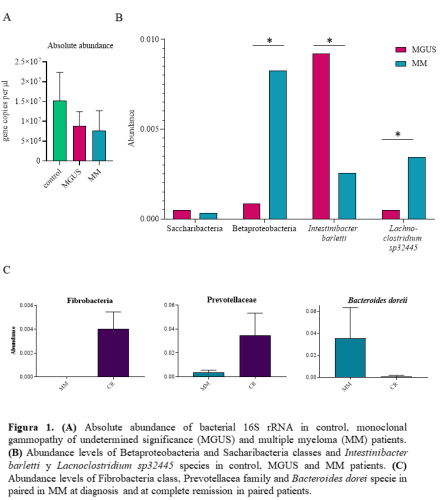
Contributions
Abstract: EP952
Type: E-Poster Presentation
Session title: Myeloma and other monoclonal gammopathies - Biology & Translational Research
Background
There is an increasing evidence that the gut microbiota exerts an influence on the immune system, inflammatory mechanisms, and the tumor microenvironment. The presence of these microorganisms and their activity could have an impact on immune cells and the bone marrow, playing an important role in the origin and development of multiple myeloma (MM).
Aims
In this work we explore which microorganisms of the intestinal microbiota could be imbalanced in monoclonal gammopathies and their possible role in the development of multiple myeloma.
Methods
22 stool samples from patients with monoclonal gammopathy of undetermined significance (MGUS) (n = 8), and multiple myeloma at diagnosis (MM) (n = 9) and in complete remission (CR) (n = 5, 3 of them paired with their diagnostic samples). Furthermore, healthy patients (n = 5) whose median age and gender ratio were similar to that of the patients were included as controls. After the extraction of the microbial DNA with the Qiagen AllPrep® PowerFecal® DNA / RNA kit, the ribosomal subunit of the bacterial 16S gene was sequenced using the Quick-16S ™ NGS Library Prep Kit (Zymo Research) for library generation. After sequencing on the Illumina® MiSeq ™, bioinformatic analysis and quantification of absolute abundance were carried out.
Results
The absolute abundance of bacterial 16 rRNA was decreased in patients with gammopathies (1A). The abundance levels of Saccharibacteria and Betaproteobacteria classes was increased in patients with MGUS and MM. Moreover, there was a significant increase in MM compared to MGUS patients in the Betaproteobacteria class and the Lachnoclostridium sp32445 specie. By contrast, the abundance of the specie Intestinibacter barletti was higher in MGUS compared to MM patients (Fig. 1B). When comparing the paired samples, it was observed that an increase in the microorganisms of Fibrobacteria class and Prevotellaceae family upon reaching complete remission, contrary to Bacteroides doreii specie, which was increased at the diagnosis moment (1C).

Conclusion
The level of abundance of the microorganisms studied shows differences between the groups of MGUS and MM patients at diagnosis compared to controls, as well as in MM patients between at diagnosis and at RC moments. This study suggests that the analysis of the intestinal microbiota in patients with monoclonal gammopathies could be of prognostic utility.
Keyword(s): MGUS, Microenvironment, Myeloma
Abstract: EP952
Type: E-Poster Presentation
Session title: Myeloma and other monoclonal gammopathies - Biology & Translational Research
Background
There is an increasing evidence that the gut microbiota exerts an influence on the immune system, inflammatory mechanisms, and the tumor microenvironment. The presence of these microorganisms and their activity could have an impact on immune cells and the bone marrow, playing an important role in the origin and development of multiple myeloma (MM).
Aims
In this work we explore which microorganisms of the intestinal microbiota could be imbalanced in monoclonal gammopathies and their possible role in the development of multiple myeloma.
Methods
22 stool samples from patients with monoclonal gammopathy of undetermined significance (MGUS) (n = 8), and multiple myeloma at diagnosis (MM) (n = 9) and in complete remission (CR) (n = 5, 3 of them paired with their diagnostic samples). Furthermore, healthy patients (n = 5) whose median age and gender ratio were similar to that of the patients were included as controls. After the extraction of the microbial DNA with the Qiagen AllPrep® PowerFecal® DNA / RNA kit, the ribosomal subunit of the bacterial 16S gene was sequenced using the Quick-16S ™ NGS Library Prep Kit (Zymo Research) for library generation. After sequencing on the Illumina® MiSeq ™, bioinformatic analysis and quantification of absolute abundance were carried out.
Results
The absolute abundance of bacterial 16 rRNA was decreased in patients with gammopathies (1A). The abundance levels of Saccharibacteria and Betaproteobacteria classes was increased in patients with MGUS and MM. Moreover, there was a significant increase in MM compared to MGUS patients in the Betaproteobacteria class and the Lachnoclostridium sp32445 specie. By contrast, the abundance of the specie Intestinibacter barletti was higher in MGUS compared to MM patients (Fig. 1B). When comparing the paired samples, it was observed that an increase in the microorganisms of Fibrobacteria class and Prevotellaceae family upon reaching complete remission, contrary to Bacteroides doreii specie, which was increased at the diagnosis moment (1C).

Conclusion
The level of abundance of the microorganisms studied shows differences between the groups of MGUS and MM patients at diagnosis compared to controls, as well as in MM patients between at diagnosis and at RC moments. This study suggests that the analysis of the intestinal microbiota in patients with monoclonal gammopathies could be of prognostic utility.
Keyword(s): MGUS, Microenvironment, Myeloma


